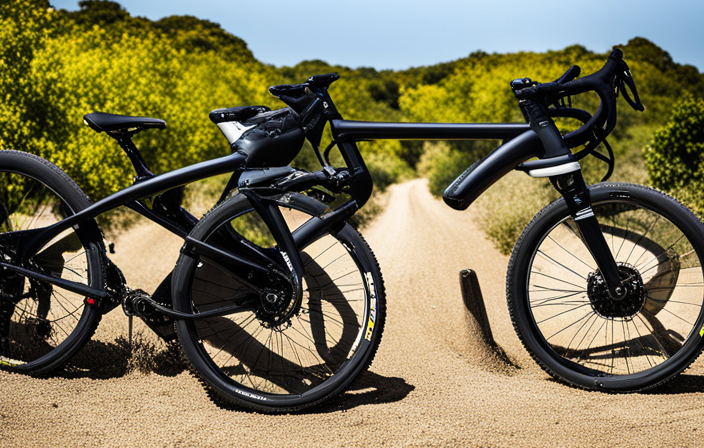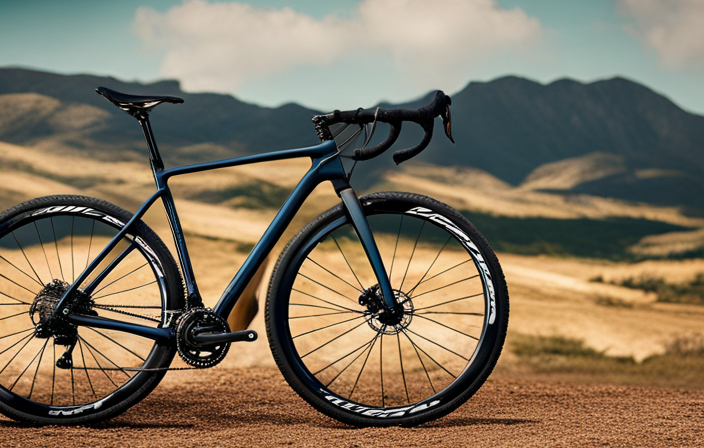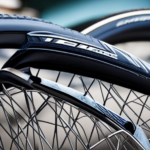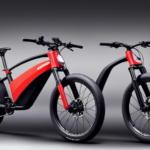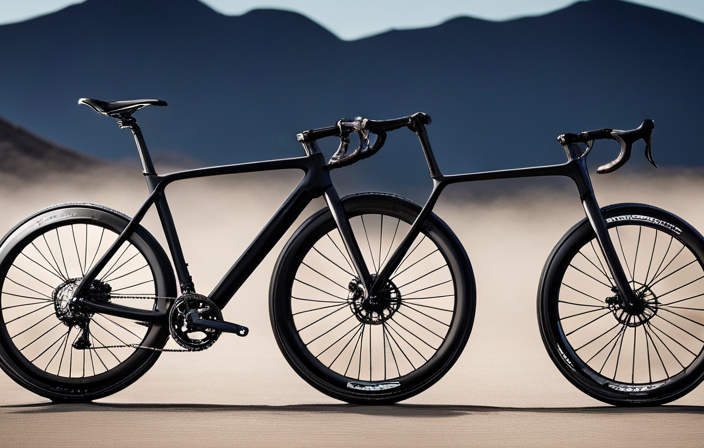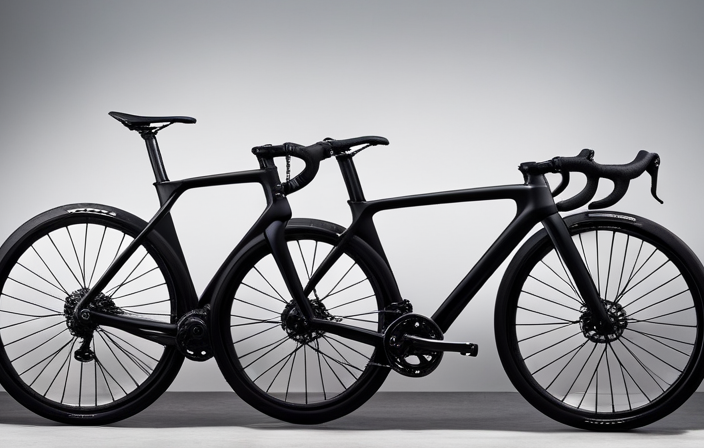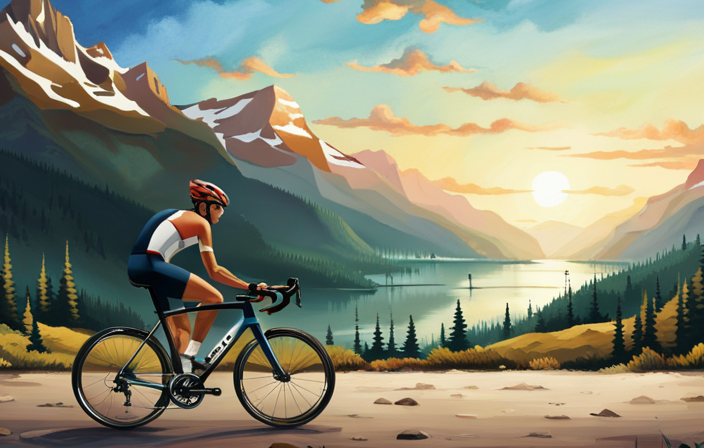Riding a gravel bike feels like exploring unknown terrain, with each pedal pushing us towards exciting new experiences. As we delve into this exhilarating world of off-road cycling, it’s normal to ask ourselves: what is considered a decent average speed on a gravel bike?
In this article, we delve into the nitty-gritty details, considering factors such as terrain, fitness level, and bike setup. Join me on this journey as we uncover the secrets to maximizing speed and conquering the gravel trails with finesse.
Key Takeaways
- Average speed on a gravel bike is influenced by factors such as terrain conditions, weather conditions, bike setup, and fitness level.
- Good bike handling skills, proper nutrition, and hydration are crucial for optimizing performance and maintaining a good average speed.
- Tire pressure, tread patterns, and body positioning play a significant role in enhancing traction and control on different terrain and surface conditions.
- Fitness level, experience, and regular training rides contribute to maintaining a faster average speed on a gravel bike.
Understanding the Basics of Gravel Biking
Understanding the basics of gravel biking can help riders determine a good average speed on their gravel bikes. Gravel biking is a unique discipline that combines elements of road cycling and mountain biking. To excel in this sport, riders need to develop specific training techniques and follow proper nutrition tips.
When it comes to training for gravel biking, it’s important to focus on endurance and strength. Long rides at a steady pace are crucial for building the necessary stamina to tackle rough terrain. Additionally, incorporating interval training sessions can improve power output during short bursts of intense effort.
Nutrition plays a vital role in maintaining energy levels during long rides. It’s essential to fuel your body with the right balance of carbohydrates, proteins, and fats before, during, and after each ride. Hydration is also key to preventing fatigue and cramping.
Factors affecting average speed on a gravel bike include terrain conditions, weather conditions, bike setup, and individual fitness level. Steep climbs or loose gravel surfaces can significantly impact speed. Weather conditions such as strong headwinds or muddy trails can also slow down progress.
In conclusion, understanding the basics of gravel biking involves learning effective training techniques and following proper nutrition tips. These factors contribute to determining a good average speed on a gravel bike while taking into account various external factors that affect performance on different terrains and under different weather conditions.
Factors Affecting Average Speed on a Gravel Bike
To improve your overall pace on a gravel bike, you should consider factors such as terrain, tire pressure, and your fitness level. These elements can greatly impact your average speed and ultimately enhance your performance on the bike.
Here are some key points to keep in mind:
-
Bike handling skills: Having good bike handling skills is essential for maintaining control and navigating through challenging terrains. It allows you to maneuver smoothly and efficiently, which can positively affect your speed.
-
Nutritional strategies: Fueling yourself properly before and during a ride is crucial for sustaining energy levels. Adequate hydration and consuming the right balance of carbohydrates and proteins can help optimize performance and prevent fatigue.
Maintaining the correct tire pressure is another important aspect that affects average speed. Lower pressures provide better traction on rough surfaces but can increase rolling resistance, while higher pressures may offer greater efficiency but sacrifice comfort.
Your fitness level plays a significant role in determining how fast you can go on a gravel bike. Regular training rides focusing on endurance, strength, and interval workouts will improve cardiovascular fitness and muscular strength, enabling you to sustain higher speeds for longer durations.
Understanding these factors will help you maximize your potential while riding a gravel bike. In the next section about ‘terrain and surface conditions’, we will delve into how different landscapes impact average speed without compromising safety or enjoyment.
Terrain and Surface Conditions
When riding on different types of terrain and surfaces, the condition of the ground can greatly impact your overall pace. Gravel biking involves navigating through various terrains such as loose gravel, mud, sand, and uneven surfaces. These factors can affect traction and bike handling, which in turn affects your average speed.
Improving traction is crucial when riding on challenging terrain. To enhance traction, there are several techniques you can employ. One effective method is adjusting tire pressure to match the conditions. Lowering the pressure increases tire surface area contact with the ground, improving grip. Additionally, choosing tires with appropriate tread patterns for different terrains can greatly enhance traction.
Bike handling techniques are also important for maintaining a good average speed on varying surfaces. Proper body positioning and weight distribution play a significant role in navigating obstacles and maintaining control. Learning how to effectively shift your weight while cornering or descending can help you maintain momentum without sacrificing stability.
Transitioning into the next section about ‘fitness level and experience,’ it’s essential to note that while terrain and surface conditions significantly impact average speed on a gravel bike, these factors go hand in hand with one’s fitness level and experience.
Fitness Level and Experience
Improving your fitness level and gaining experience are key factors in maximizing your performance while riding on different terrains. When it comes to gravel biking, being physically fit is essential for maintaining a good average speed. Training techniques such as interval training, hill repeats, and long endurance rides can help improve your cardiovascular fitness and increase your overall endurance. Incorporating strength training exercises into your routine will also benefit you, as it will enhance your power output and stability on the bike.
In addition to training techniques, paying attention to nutritional guidelines is crucial for optimizing your performance. Ensuring you have a well-balanced diet that includes carbohydrates for energy, protein for muscle repair and recovery, and healthy fats for sustained energy can make a significant difference in how you feel during rides. Hydration is equally important; staying properly hydrated before, during, and after rides will help prevent fatigue and maintain optimal performance.
As you gain more experience on the gravel bike, you’ll become more efficient at handling various terrain conditions. You’ll learn how to read the surface better and adjust your body position accordingly. Additionally, becoming familiar with different gear ratios and shifting techniques will allow you to navigate through challenging sections with ease.
Transitioning into the subsequent section about bike setup and components, it’s important to consider how these elements work together to enhance your overall riding experience without compromising speed or comfort.
Bike Setup and Components
Ensure you have the right bike setup and components to enhance your riding experience on different terrains. One crucial factor is bike fit, as it can significantly affect your comfort and performance. A properly fitted gravel bike will allow for efficient power transfer and reduce the risk of injury. Consider adjusting the saddle height, handlebar reach, and overall frame size to match your body proportions.
In addition to bike fit, nutrition and hydration are essential for optimal performance on a gravel bike. Riding off-road can be physically demanding, so fueling your body with the right nutrients is crucial. Make sure to consume a balanced diet that includes carbohydrates for energy, protein for muscle repair, and healthy fats for sustained endurance.
When it comes to components, consider equipping your gravel bike with features that enhance its versatility on different surfaces. Opt for wider tires with tread patterns designed for off-road riding. Additionally, a suspension fork or seatpost can improve comfort and control over rough terrain.
By ensuring proper bike fit and considering key components like tire choice and suspension options, you’ll be better equipped to tackle various terrains on your gravel bike. Setting realistic expectations about average speed will come into play as you fine-tune these elements of your setup without feeling overwhelmed by an unrealistic goal achievement mindset.
Setting Realistic Expectations
Setting realistic expectations for your performance is key to enjoying your riding experience and avoiding unnecessary pressure. When it comes to gravel biking, there are a few training techniques and nutrition tips that can help you improve your average speed.
Here are three strategies to consider:
-
Interval Training: Incorporating interval training into your workouts can significantly increase your speed and endurance. This involves alternating between high-intensity efforts and recovery periods, helping you build the necessary power for faster riding.
-
Strength Training: Building strength in your legs and core is crucial for maintaining a good average speed on gravel terrain. Incorporate exercises like squats, lunges, and planks into your routine to improve your overall stability and power output.
-
Proper Nutrition: Fueling your body with the right nutrients will enhance your performance on the bike. Prioritize carbohydrates for energy, lean proteins for muscle repair, and healthy fats for sustained endurance.
By implementing these training techniques and nutrition tips, you can set realistic expectations for yourself while also improving your average speed on a gravel bike.
In the next section, we will explore the average speed ranges that beginner gravel bikers should aim for as they develop their skills further without feeling overwhelmed by unrealistic targets.
Average Speed Ranges for Beginner Gravel Bikers
To develop your skills further as a beginner gravel biker, it’s important to have an understanding of the average range of speeds you should aim for.
As a beginner, it’s normal to start with lower speeds and gradually increase your pace as you gain experience and improve your endurance. When starting out on a gravel bike, you can expect to ride at an average speed ranging from 10 to 12 miles per hour. This range allows you to build a solid foundation while getting accustomed to the unique challenges of riding off-road.
As you become more comfortable and proficient on your bike, you can aim for an average speed between 12 to 14 miles per hour. To achieve this, focus on improving your endurance by gradually increasing the distance of your rides and incorporating interval training sessions. It’s also essential to work on your pedaling technique, finding the right gear ratios for different terrains, and maintaining a steady cadence.
By consistently practicing these beginner gravel bike tips and steadily increasing your speed range, you’ll be well-prepared to transition into the next level: intermediate gravel biking. In this section, we will explore the average speed ranges for intermediate riders who are looking to push their limits even further.
Average Speed Ranges for Intermediate Gravel Bikers
If you’re an intermediate gravel biker looking to challenge yourself and push your limits even further, it’s important to have a clear understanding of the range of speeds you can aim for. As an intermediate rider, you should already have a good grasp of basic bike handling skills and be comfortable riding on different terrains. Your average speed will typically be higher compared to beginners, but it will still depend on various factors such as fitness level, terrain difficulty, and weather conditions.
To give you a better idea of what average speed ranges are achievable for intermediate gravel bikers, I’ve created a table showcasing three different levels: beginner-intermediate, solid intermediate, and advanced-intermediate. Take note that these speeds are just general guidelines and may vary depending on individual circumstances.
| Level | Average Speed Range (mph) |
|---|---|
| Beginner-Intermediate | 12 – 14 |
| Solid Intermediate | 14 – 16 |
| Advanced-Intermediate | 16 – 18 |
To improve your average speed limits as an intermediate rider, incorporating structured training methods into your routine can be beneficial. Interval training, hill repeats, and longer endurance rides can help build strength and increase overall fitness. Remember to always listen to your body and gradually progress with your training.
As an intermediate gravel biker aiming to become more advanced in terms of average speed ranges, it’s crucial to constantly seek new challenges while focusing on consistent training methods.
Average Speed Ranges for Advanced Gravel Bikers
When you’re an advanced gravel biker, your experience and skill level allow you to achieve even higher average speeds on challenging terrains. With improved bike handling skills and a deeper understanding of how to navigate various surfaces, you can confidently push the limits of your speed. Advanced riders often have a keen sense of line choice, allowing them to take the most efficient path through gravel trails. This, combined with their ability to maintain momentum through corners and technical sections, enables them to maintain high speeds throughout their rides.
In addition to bike handling skills, nutrition and hydration play a crucial role in maintaining optimal performance as an advanced gravel biker. Fueling your body properly before, during, and after rides ensures that you have the energy and endurance needed for intense efforts. Staying hydrated is equally important as it helps prevent muscle cramps and fatigue.
As we move into the next section about tips for improving your average speed on a gravel bike, it’s essential to remember that small adjustments can make a big difference. By fine-tuning technique and optimizing nutrition strategies, you can continue to challenge yourself and reach new levels of speed on any terrain without compromising safety or comfort.
Tips for Improving Your Average Speed on a Gravel Bike
One effective way to enhance your performance on a gravel bike is by implementing small adjustments and optimizing your technique and nutrition strategies. Here are some tips to help improve your average speed on a gravel bike:
-
Bike handling techniques:
-
Practice maintaining a stable body position while riding over rough terrain. This will help you stay balanced and in control, allowing you to ride faster.
-
Learn how to effectively use your gears. Shifting at the right time can make a significant difference in your speed and efficiency.
-
Master cornering skills by leaning into turns and using proper weight distribution. This will enable you to maintain momentum without losing control.
-
Nutrition and hydration:
-
Stay properly fueled during rides by consuming a mix of carbohydrates, proteins, and fats. This will provide you with sustained energy throughout your ride.
-
Hydrate regularly to prevent dehydration, which can negatively impact your performance.
-
Consider using electrolyte supplements or sports drinks to replenish lost minerals and salts during longer rides.
By implementing these bike handling techniques and optimizing your nutrition and hydration strategies, you can improve your average speed on a gravel bike.
In the next section about ‘training and conditioning’, we will explore additional ways to further enhance your performance without writing ‘step’.
Training and Conditioning
In my previous section, I provided some valuable tips for improving your average speed on a gravel bike. Now, let’s delve into the importance of training and conditioning to enhance your performance on the trails.
To excel in gravel biking, it is crucial to focus on both physical fitness and bike handling techniques. By incorporating regular training sessions into your routine, you can build endurance, strength, and power necessary for tackling challenging terrains. Additionally, practicing specific bike handling skills such as cornering and descending can significantly improve your overall speed and control on the bike.
Proper nutrition and hydration are also key factors in maximizing your performance. Fueling your body with a well-balanced diet that includes carbohydrates, proteins, and healthy fats will provide you with the energy required for those long rides. Staying hydrated throughout your training sessions is equally important to prevent muscle cramps and fatigue.
Let’s now transition into our next topic: bike maintenance and upgrades. By ensuring that our bikes are in top-notch condition and exploring potential upgrades, we can further optimize our riding experience.
Bike Maintenance and Upgrades
To enhance your performance on the trails, it’s important to prioritize bike maintenance and consider potential upgrades. When it comes to gravel biking, having a well-maintained bike can make all the difference in terms of speed and efficiency.
One key aspect of bike maintenance is following a regular schedule for tasks such as cleaning, lubricating the chain, checking tire pressure, and inspecting brake pads. By keeping up with these routine tasks, you can ensure that your bike is in optimal condition for riding.
In addition to regular maintenance, considering upgrades can also help improve your average speed on a gravel bike. Upgrading components like tires, wheels, or even the drivetrain can have a significant impact on how smoothly your bike rolls over rough terrain. For example, investing in tubeless tires can reduce the chances of getting flats while providing better traction on loose surfaces.
By maintaining your bike properly and considering upgrades when necessary, you’ll be able to maximize your performance on the trails. However, it’s important to remember that even with the best equipment, proper gear and clothing are equally essential for a successful ride.
Proper Gear and Clothing
When it comes to bike maintenance and upgrades, there are several factors that can affect your overall performance on a gravel bike. However, even with the best equipment and tune-ups, it’s important to not overlook the significance of proper gear and clothing.
As an experienced rider, I understand the importance of wearing the right gear for optimal performance and comfort.
Proper nutrition plays a vital role in sustaining energy levels during long rides. Consuming a balanced diet rich in carbohydrates, proteins, and healthy fats can help fuel your muscles and keep you going strong. Additionally, staying hydrated is crucial for maintaining endurance and preventing cramps. Remember to drink plenty of water before, during, and after your ride.
In terms of clothing, investing in high-quality cycling apparel can greatly enhance your riding experience. Look for moisture-wicking fabrics that will keep you dry and comfortable throughout your ride. Don’t forget about protective gear such as helmets and gloves to ensure safety on rough terrain.
Now that we have covered proper nutrition and hydration tips for gravel biking, let’s move on to strategies for tackling challenging terrain without compromising our speed or stability.
Strategies for Tackling Challenging Terrain
One effective way to navigate difficult terrain while maintaining stability and speed is by utilizing proper body positioning and weight distribution on the bike. When descending steep hills, it’s important to shift your body weight towards the back of the bike. This helps keep your center of gravity low and provides more traction on the rear wheel, preventing it from skidding or losing control.
Additionally, bending your elbows and knees slightly will act as a suspension system, absorbing any bumps or roughness in the terrain.
When navigating technical sections such as rocky trails or tight corners, it’s crucial to maintain an active stance on the bike. This means keeping your body loose and flexible, allowing you to quickly react and adjust to changes in terrain. By shifting your weight from side to side during turns, you can effectively grip the bike while maintaining balance.
Incorporating these strategies into your riding technique will not only improve your stability but also enhance your overall speed on challenging terrains. Transitioning smoothly between different sections requires practice and confidence in handling various obstacles.
Moving forward into safety considerations and riding etiquette, it’s important to always be aware of other riders and trail users, ensuring a safe and enjoyable experience for everyone involved.
Safety Considerations and Riding Etiquette
Remember to always prioritize safety and practice proper riding etiquette while on the trails. When it comes to gravel biking, there are specific riding techniques that can help you navigate challenging terrain more effectively.
One important technique is maintaining a relaxed grip on the handlebars, which allows for better control and stability over rough surfaces. Additionally, shifting your weight back when descending steep sections helps maintain balance and prevents you from going over the handlebars.
When participating in group rides, it’s crucial to communicate with other riders about obstacles ahead or any potential hazards. This ensures everyone’s safety and helps create a cohesive riding experience. It’s also important to be aware of your surroundings and yield to pedestrians or other trail users.
Riding etiquette extends beyond just safety considerations. Being respectful towards others on the trail by not littering, minimizing noise pollution, and following any posted regulations or rules is essential. Remember that you are sharing these trails with others who may have different preferences or goals.
Transitioning into the next section about the benefits of gravel biking beyond average speed, consider how incorporating these riding techniques and practicing good etiquette can enhance not only your personal enjoyment but also contribute positively to the overall gravel biking community.
Benefits of Gravel Biking Beyond Average Speed
Apart from the speed and terrain, gravel biking offers a range of advantages that extend beyond the norm. Not only is it a great way to explore new areas and challenge yourself physically, but it also provides numerous benefits for mental health and overall well-being.
-
Bikepacking Adventures: Gravel biking allows you to venture off the beaten path and embark on exciting bikepacking adventures. With a gravel bike’s versatility, you can easily carry all your essential gear for overnight trips or multi-day journeys. It opens up a whole new world of exploration and freedom.
-
Mental Health Benefits: Riding a gravel bike in nature has proven to have positive effects on mental health. The combination of physical activity, fresh air, and natural surroundings can help reduce stress levels, improve mood, and increase overall happiness. It provides an escape from the pressures of daily life and promotes mindfulness.
-
Sense of Accomplishment: Conquering challenging terrains on a gravel bike gives you a sense of achievement like no other. The satisfaction that comes from pushing yourself outside your comfort zone and successfully navigating difficult trails is unparalleled.
-
Connection with Nature: Gravel biking allows you to immerse yourself in nature like never before. Riding through scenic landscapes, listening to birds chirping, feeling the wind on your face – it’s an experience that brings you closer to the natural world around you.
-
Social Interaction: Gravel biking has gained popularity as a social activity where riders come together to explore new routes or take part in organized events. It’s an opportunity to meet like-minded individuals who share your passion for adventure on two wheels.
As you delve into the world of gravel biking with its multitude of benefits, tracking and analyzing your speed and progress becomes vital in maximizing your potential for growth and improvement.
Tracking and Analyzing Your Speed and Progress
To get the most out of your gravel biking experience, it’s important to track and analyze how fast you’re going and monitor your progress along the way. By employing various tracking techniques and analyzing the data, you can gain valuable insights into your performance and make informed decisions to improve your average speed.
One effective way to track your speed is by using a GPS bike computer or a smartphone app. These devices not only provide real-time information about your current speed but also record data such as distance covered, elevation gained, and even heart rate. This data can be analyzed later to identify patterns, set goals, and measure improvements over time.
Analyzing this data requires attention to detail and an understanding of key metrics. Average speed is one important indicator of progress, but it should be considered alongside other factors like power output, cadence, and heart rate variability. By comparing these metrics across different rides or intervals, you can identify areas for improvement and tailor your training accordingly.
Learning from the gravel biking community is essential for continued growth in this sport. Engaging with fellow riders through online forums or local group rides allows you to share experiences, exchange tips on tracking techniques, and learn from others who have successfully improved their average speed.
With the right tools and knowledge at hand, you can continually push yourself towards achieving new milestones in gravel biking performance without compromising safety or enjoyment.
Learning from the Gravel Biking Community
Transitioning from tracking and analyzing my speed and progress, I realized that learning from the gravel biking community has been invaluable in improving my average speed on a gravel bike. Through interactions with fellow riders, online forums, and social media groups dedicated to gravel biking, I have gained valuable insights and knowledge about techniques, strategies, and equipment that can enhance my performance.
Here are four key things I have learned from the gravel biking community:
-
Gravel Bike Accessories: Discovering the right accessories for my bike, such as tubeless tires for better traction on rough terrain or a bike computer to accurately measure my speed and distance, has greatly improved my overall riding experience.
-
Gravel Bike Events: Participating in local gravel bike events not only offers an opportunity to challenge myself against other riders but also provides a platform for sharing experiences and exchanging tips with seasoned cyclists.
-
Training Methods: Learning about different training methods specifically tailored for gravel biking has allowed me to focus on aspects like endurance, strength, and technical skills required for tackling varied terrains effectively.
-
Route Recommendations: The community’s recommendations for scenic routes or hidden gems have broadened my horizons by exposing me to new trails that offer both challenging terrain and breathtaking views.
By incorporating these learnings into my rides, I have seen significant improvements in my average speed on a gravel bike. Now let’s explore some common mistakes to avoid for better speed performance…
Common Mistakes to Avoid for Better Speed Performance
One important aspect to consider for improving your speed performance is avoiding common mistakes. When it comes to training techniques, consistency is key. It’s crucial to have a structured training plan that includes a mix of endurance rides, interval sessions, and strength training exercises. By following this approach, you can build both your aerobic and anaerobic capacities, which are essential for better speed performance on a gravel bike.
Another mistake to avoid is neglecting nutrition. Fueling your body properly before, during, and after rides can significantly impact your speed and endurance. Focus on consuming a balanced diet that includes carbohydrates for energy, protein for muscle recovery, and healthy fats for sustained energy. Additionally, stay hydrated by drinking enough water throughout the day and during your rides.
Incorporating these training techniques and nutrition tips into your routine will help optimize your speed performance on a gravel bike. Once you’ve mastered these elements, you’ll be ready to explore different gravel biking routes and destinations with confidence in your abilities. Whether it’s tackling challenging climbs or enjoying scenic trails, the right preparation will ensure an enjoyable and successful riding experience without missing a beat.
Exploring Different Gravel Biking Routes and Destinations
When you’re ready, go out and discover the countless options for exploring new routes and destinations on your gravel bike. Gravel biking offers a whole world of possibilities, from scenic countryside roads to challenging off-road trails.
One way to discover new routes is by participating in gravel bike events. These events not only provide an opportunity to ride with like-minded individuals but also showcase some of the best routes in the area. Whether it’s a short race or a longer endurance event, these organized rides offer unique experiences that can push your limits and improve your skills.
If you’re looking for more adventure, consider gravel bikepacking adventures. With the right gear and planning, you can embark on multi-day trips that take you through breathtaking landscapes and remote areas. From rugged mountains to serene forests, there are endless opportunities for exploration.
By exploring different routes and destinations on your gravel bike, you’ll not only have fun but also enhance your riding abilities. You’ll become familiar with various terrains, learn how to navigate different surfaces, and develop better bike handling skills.
As you continue to explore new routes and challenge yourself with gravel bike events or bikepacking adventures, celebrate your personal achievements and progression. Each ride is an opportunity for growth, whether it’s conquering a difficult climb or completing a long-distance journey. Embrace these accomplishments as markers of your dedication and passion for this thrilling sport.
Celebrating Personal Achievements and Progression
Embrace the milestones and progress you achieve in gravel biking as a testament to your dedication and growth in this exhilarating sport. Celebrating personal achievements is an important part of any athletic endeavor, including gravel biking. It not only motivates us to continue pushing ourselves but also shows how far we have come.
One way to celebrate accomplishments in gravel biking is by measuring progress. A great way to do this is by tracking your average speed over time. As you become more experienced and stronger, you will notice improvements in your average speed. This can be incredibly rewarding and satisfying.
To help visualize your progress, consider using a table like the one below:
| Ride | Distance (miles) | Average Speed (mph) |
|---|---|---|
| 1 | 10 | 12 |
| 2 | 15 | 13 |
| 3 | 20 | 14 |
As you can see from the table, there is a clear progression in both distance and average speed with each ride. This tangible evidence of improvement can serve as a powerful motivator to keep pushing yourself further.
Remember, celebrating personal achievements doesn’t mean comparing yourself to others or setting unrealistic expectations. It’s about acknowledging your own growth and enjoying the journey of becoming a better gravel biker. So go out there, track your progress, and revel in every milestone along the way!
Frequently Asked Questions
Can I use a gravel bike for road cycling?
Yes, you can definitely use a gravel bike for road cycling. While it may not be as fast as a dedicated road bike, the versatility of a gravel bike allows it to handle various terrains and surfaces with ease.
It features wider tires for added stability and comfort on rough roads, while still maintaining efficiency on smooth pavement. The benefits of using a gravel bike on the road include improved traction, increased durability, and the ability to explore different routes beyond traditional asphalt roads.
How often should I clean and maintain my gravel bike?
I recommend cleaning and maintaining your gravel bike regularly to ensure optimal performance and longevity. The cleaning frequency depends on various factors such as riding conditions, but a general rule of thumb is to clean it after every ride or at least once a week.
This involves removing dirt, mud, and debris from the frame, drivetrain, brakes, and wheels. Additionally, necessary maintenance includes checking and adjusting components like tire pressure, chain lubrication, brake alignment, and spoke tension.
What are some essential safety considerations when riding a gravel bike?
When it comes to riding a gravel bike, safety should be your top priority.
There are several essential safety considerations to keep in mind.
First and foremost, always wear a helmet to protect your head in case of a fall.
Additionally, proper gear selection is crucial to maintain control on unpredictable terrain.
Make sure you have sturdy tires with good traction and consider using flat pedals or toe cages for added stability.
Remember, being prepared and cautious will help ensure a safe and enjoyable ride.
How can I track and analyze my speed and progress on a gravel bike?
To track and analyze my speed and progress on a gravel bike, I rely on cycling computer devices. These devices record various metrics such as speed, distance, time, and even elevation.
By syncing these data with compatible smartphone apps or computer software, I can thoroughly assess my performance over time. This allows me to identify areas for improvement, set goals, and track my progress in real-time during rides.
With this information at hand, I can continuously monitor and enhance my gravel biking experience.
Are there any specific strategies or techniques for tackling challenging terrain on a gravel bike?
When it comes to tackling challenging terrain on a gravel bike, mastering gravel bike handling is essential. It’s like dancing with the road, where balance and finesse are key.
To enhance control, choosing the right tire pressure is crucial. A lower pressure provides better traction and shock absorption, while a higher pressure reduces rolling resistance. Experimenting with different pressures will help find the sweet spot for your riding style and the specific terrain you’re conquering.
Conclusion
In conclusion, gravel biking is a thrilling and challenging sport that offers a unique experience for cyclists of all levels.
By understanding the basics, considering the factors that affect average speed, and learning from the gravel biking community, riders can improve their performance and achieve personal goals.
One interesting statistic to evoke an emotional response is that, according to a recent study, the average speed of experienced gravel bikers on a variety of terrains ranges from 15-20 miles per hour. This showcases the incredible skill and dedication required to excel in this exhilarating sport.
So hop on your gravel bike, push your limits, and embrace the adventure!
